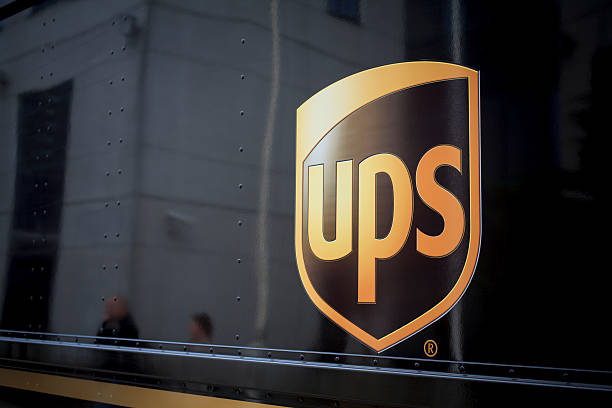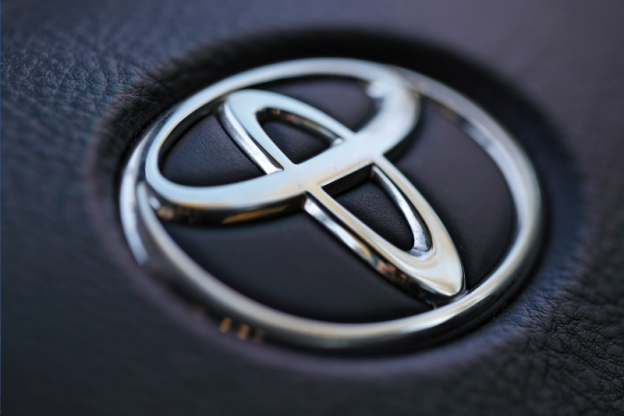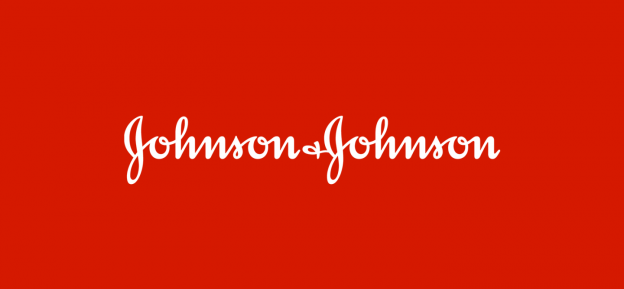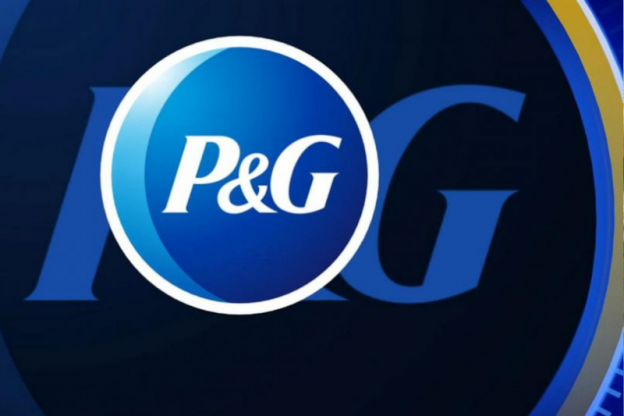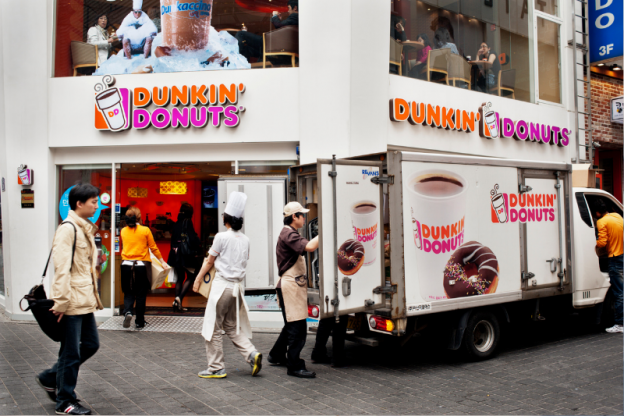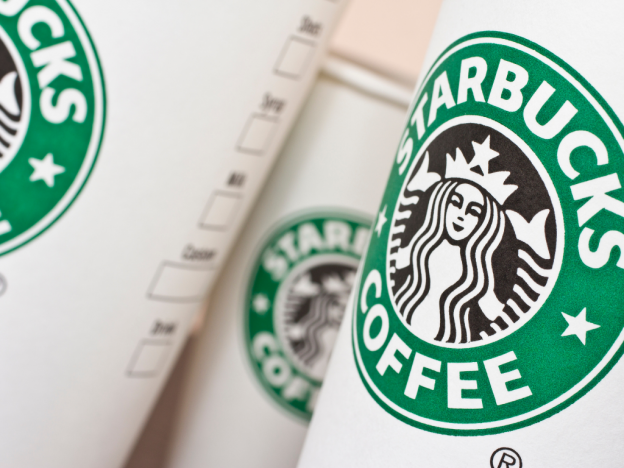This is a free Nike SWOT analysis available for all students. You should use it only as a reference.
Company Details
| Founded: | January 25, 1964, Eugene, Oregon, United States |
| Headquarters: | Beaverton, Oregon, United States |
| CEO: | John Donahoe (Jan 2020–) |
| Revenue: | 37.4 billion USD |
| Number of employees: | 75,400 (2020) |
| Subsidiaries: | Converse, RTFKT Inc., Nike Vision, NIKE Cortez,… |
| Founders: | Phil Knight, Bill Bowerman |
When it comes to quality sports apparel, footwear, accessories, and sports equipment, Nike will always come up at the top. From its beginning, it has managed to vow public and stakeholders by coming up with iconic products.
Today, Nike is ruling the relevant market segment, with competitors almost dwarf in front of it. Its revenue lines and marketing base is far much better and more rooted. That’s the reason even with the rampant pandemic and disrupted supply chains, Nike has managed to earn top dollar.
SWOT Analysis of Nike
Big brands always seem inevitable and catch the fancy of investors and researchers. To truly know the worth of a brand, SWOT Analysis is a great tool. It analyzes all the strengths, weaknesses, opportunities, and threats a business could be facing.
This gives a better and deeper look at both internal and external factors that are both contributing to its growth or hampering it.
Before we present all the findings in a square with four quadrants, it is best to take an expansive look at all the factors.
Do you want a customized SWOT Analysis for Nike? We can provide you with that! Our researchers have immense experience in doing Nike AWOT Analysis with current facts and figures. Contact us right away!
Nike’s Internal Factors
Internal strategic factors that affect Nike’s operations and worth are its strengths and weaknesses. The former gives a comparative advantage while the growth and sustainability of the latter risk.
💪 Strengths
Nike is an iconic athletic apparel and footwear brand that is synonymous with quality, agility, and better performance. The strengths of Nike are given in the section below.
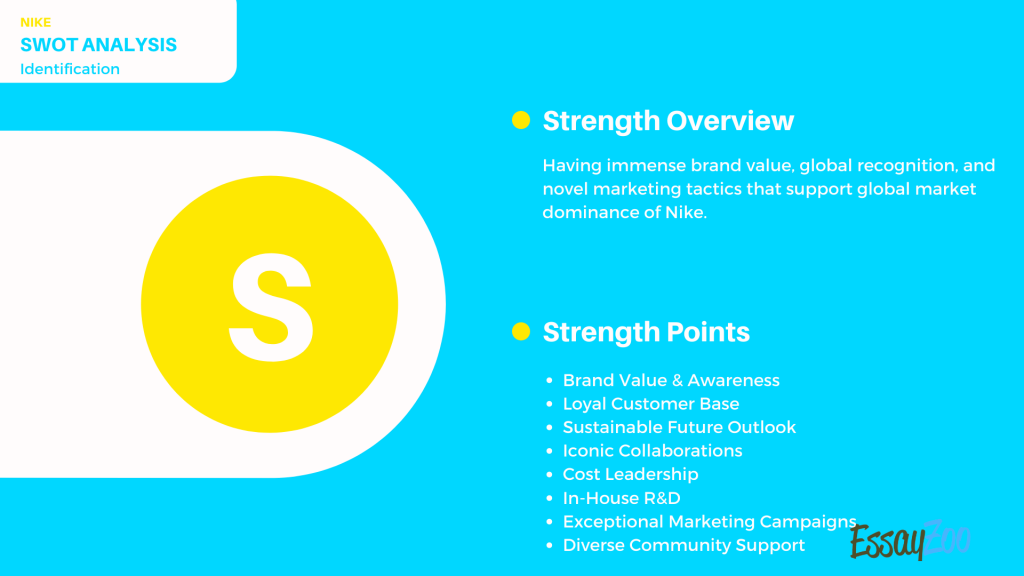
Brand Value & Awareness
Nike brand is one of the most recognizable names in the athletic footwear market. The logo, the celebrities attached to the brand, everything about Nike is truly iconic. That’s why it has yet to face alienation in any market in the world. The brand value of $42.5 billion is a testament to that.
Loyal Customer Base
Nike is one of those companies that do not have to go to the customers. Rather, they would come to the brand by following its trends and coming up with new ones using products by the company. The number of customers is millions and widespread which all favors Nike.
Sustainable Future Outlook
Nike has vowed to innovate while ensuring the sustainability of the world in general and relevant communities specifically. Its CEO has publicly addressed this issue by reiterating that the brand is behind its promise to find and adopt sustainable programs.
Iconic Collaborations
Nike has never shied away from connecting and collaborating with truly iconic athletes. In NBA alone, Nike has a 97% share of sponsorship with star celebrity brand ambassadors. This has produced Air Jordan, in collaboration with Michael Jordan, shoes, and many related lines which helped the brand to rising recognition and profits.
Cost Leadership
Employing cost-effective methods, such as outsourcing manufacturing to cheaper regions, has allowed Nike to get better returns on its investment. The marginal benefits result in improved cash flow and the financial health of the business.
In-House R&D
Nike spends a fortune in procuring and recruiting professionals. The R&D budget goes to testing and developing new products in-house, such as sports shoes, before releasing them for public usage.
Exceptional Marketing Campaigns
Nike is one of the top brands in the world that spend a fortune on-demand generation. This includes connecting with potential customers through influencers, organizing media events, and publishing content. This allows the company to target more customers than its competitors.
Diverse Community Support
Diverse communities have always backed Nike for its social initiatives. In America, Nike raised its voice against racial discrimination through its campaign “Don’t Do It” which was iconic like its own slogan “Do It”.
The public praised the company’s efforts to support marginalized communities.
🤒 Weaknesses
Being a leader in the athletic wear and footwear industry, Nike faces a lot of crippling weaknesses in its models and implementation of its policies.
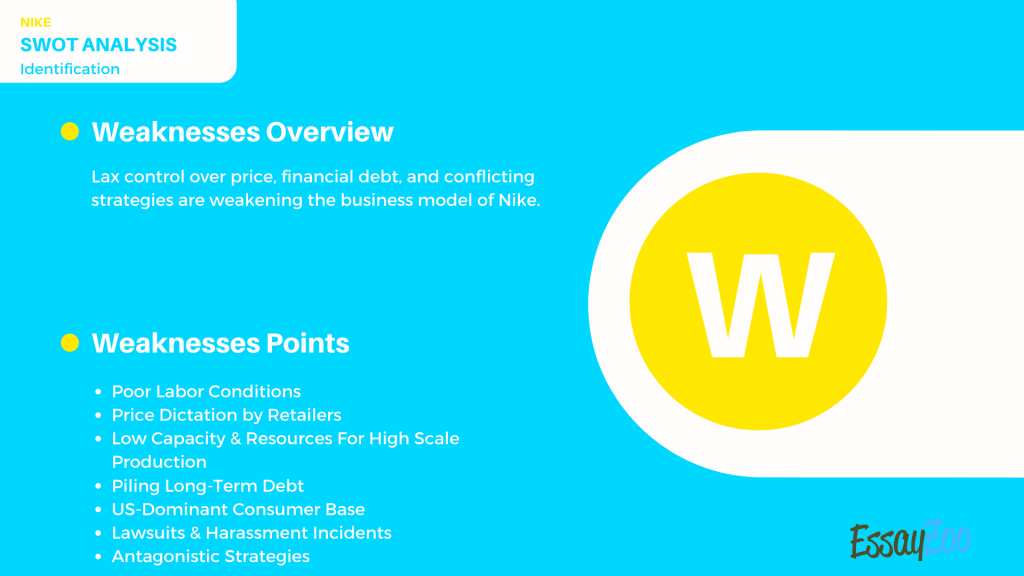
Poor Labor Conditions
Nike has been targeted by regional labor unions and human causes for providing poor labor conditions in its product regions. In Vietnam, Indonesia, etc., reports have emerged which are disturbing to the brand’s growth and sustainability.
Price Dictation by Retailers
Nike depends on retailers to sell its products for them. In turn, these retailers dictate crucial decisions like pricing and customer satisfaction. This affects Nike pledges and what it delivers on the ground.
Piling Long-Term Debt
Although Nike is reaping rewards due to its tremendous sales and growth numbers, the sword of long-term debt is still hanging above its head. The number for that debt is over $9 billion.
US-Dominant Consumer Base
Nike is considered to be a global brand due to its high recognition and affiliation with celebrities around the globe. Still, the majority of paying customers come from the US alone. This can be hampering future growth.
Lawsuits & Harassment Incidents
Since it is a big company, Nike is facing a lot of lawsuits and harassment debacles. The New York Times even published an interview conducted with 50 Nike employees. They all accused the management is involved in keeping the workplace unsafe for female workers.
Antagonistic Strategies
Nike’s “Move to Zero” came under a lot of backlashes because the company failed to keep up its promises. In previous instances, Nike pledged to move to zero carbon emissions in its processing and manufacturing lines but failed to actually “do it”.
Nike’s External Factors
The external strategic factors faced by Nike include both its opportunities and threats, where one can open new avenues for progress and growth while the other can put a stop to everything.
🤑 Opportunities
The opportunities that Nike can avail to secure its business, both at home and abroad, are discussed below.
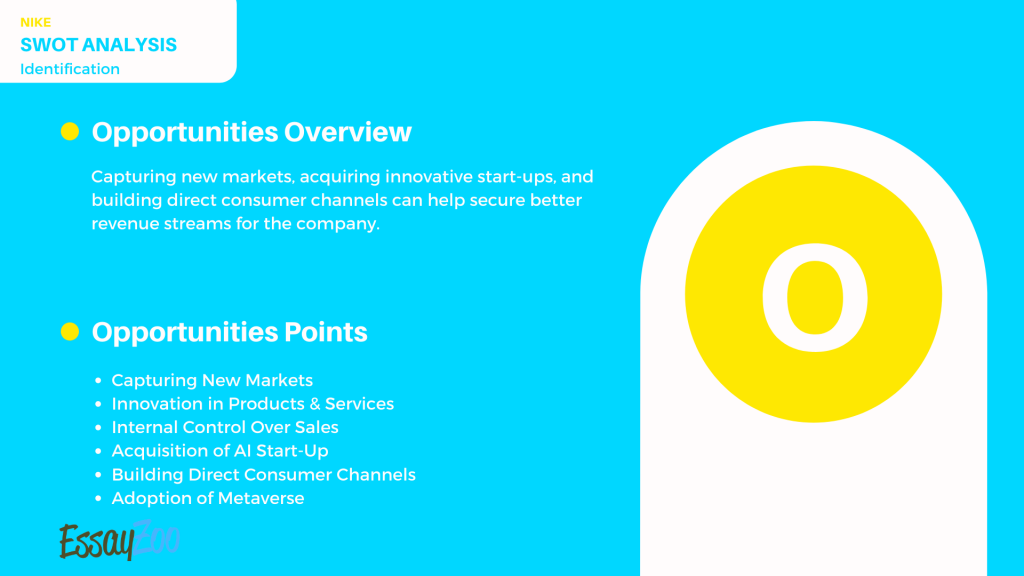
Capturing Developing Markets
Nike has a footprint in many markets around the globe. But there is still too much room for growth, especially in South America, India, China, and other emerging markets.
Innovation in Products & Services
At some point, innovation plateaued in the most innovative companies. That is exactly what happened to Nike. Still, it can work on products like “self-lacing” shoes and other items to grab public attention.
Internal Control Over Manufacturing & Sales
Nike is dependent on third-party manufacturers and retailers for its relevant operations. This leads to a loss of control over key decision-making areas, such as customer experience, pricing, and so on.
By moving these things in-house through Nike Stores, the company can have a better hold over aspects that affect its worth.
Acquisition of AI Start-Up
To better understand consumers’ online shopping behavior and enhance sales, Nike has acquired an AI start-up called “Select”. This will help the company in improving its sales and lead generation capabilities.
Building Direct Consumer Channels
By abolishing ties with retailers, Nike is working toward building new and improving older direct consumer channels. By connecting directly with end-users, the company can easily work to improve their experience and address their concerns.
Adoption of Metaverse
Nike is stepping into the metaverse by acquiring a digital shoe-making company. The company plans to design and sell virtual shoes for games and beyond while also selling them in the real world. This is another great opportunity for Nike to come up with a new revenue stream.
😨 Threats
These threats can seriously hamper the business operations of Nike as well as seriously damage its image as the leading sports brand in the world.
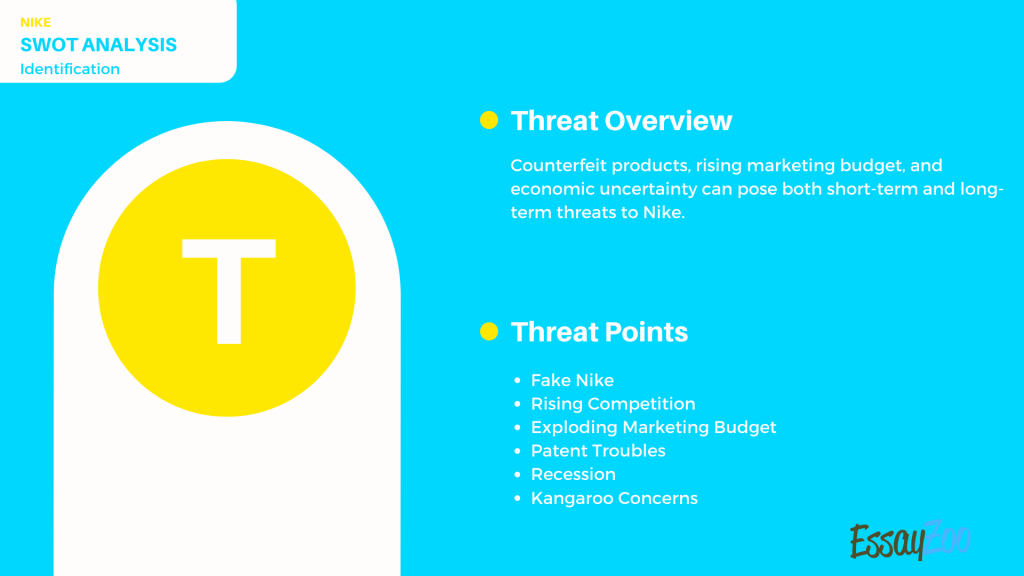
Fake Nike
Nike is one of the brands that is severely affected by counterfeit products. Its revenue and reputation are on the line thanks to “Fake” Nike products. These are ubiquitous in regions, like India, China, Brazil, etc.
Rising Competition
The competition is rising for Nike. For now, its strategies are working. The company is solely focused on one thing – creating excellent products for athletes around the globe. In the long run, it will become hard to rely on that with the rising competition from other brands, such as Under Armor, Adidas, and many more.
Exploding Marketing Budget
Its marketing budget of Nike is still on the rise but the returns in the form of lead generation and sales improvement are not proportionate. This can lead to serious damage to cash flow in the long run if things continue to go in that direction.
Patent Troubles
Patent controversies are never good for a company whether it is right or wrong. Nike has a long history of getting into trouble with other brands, such as Adidas, over products and ideas. Recently, the two giants clashed over Primeknit and Flyknit shoes in the US.
Recession
Nike is not recession-proof, and it never was. Due to economic uncertainty and the aftermath of the COVID-19 pandemic, Nike has already reported its declining sales figure, which was 38% from the last year.
If the conditions worsen, Nike will find itself in much more trouble.
Kangaroo Concerns
Nike’s commitment to using premium materials for its products often lands the company in trouble. For instance, Nike uses kangaroo skin to produce leather football shoes, and many animal rights groups and activists have shamed the company over its strategy. They have also urged Nike into alternative, plant-based options.
Nike SWOT Table
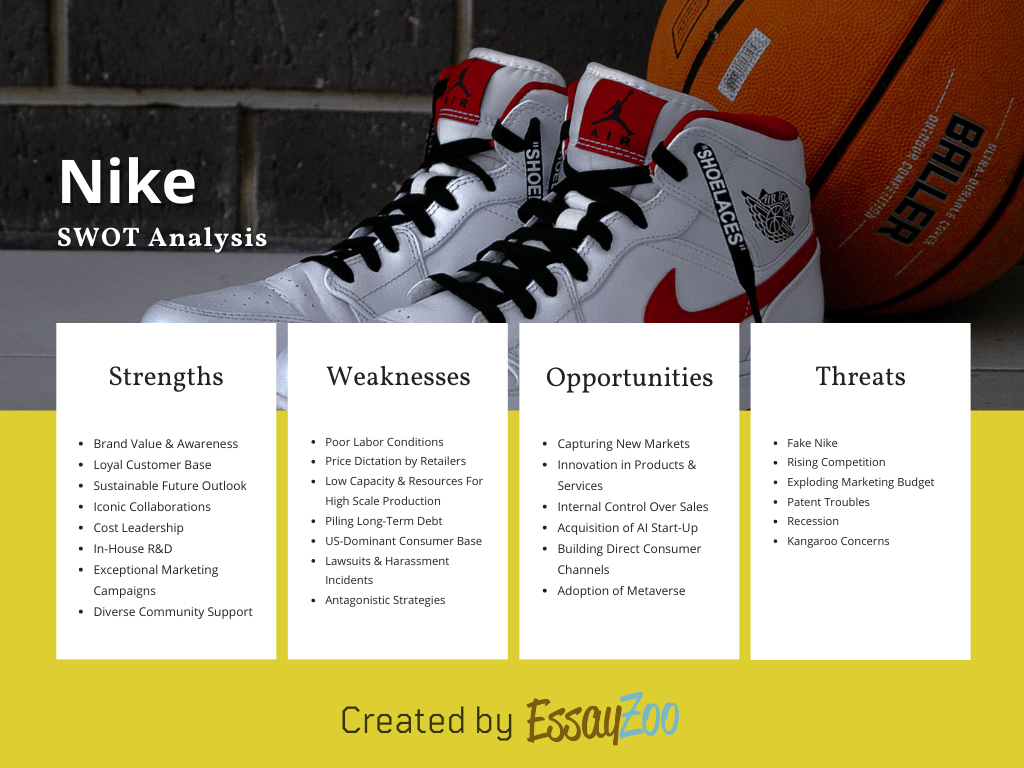
Strengths
- 💪 Brand Value & Awareness
- 💪 Loyal Customer Base
- 💪 Sustainable Future Outlook
- 💪 Iconic Collaborations
- 💪 Cost Leadership
- 💪 In-House R&D
- 💪 Exceptional Marketing Campaigns
- 💪 Diverse Community Support
Weaknesses
- 🤒 Poor Labor Conditions
- 🤒 Price Dictation by Retailers
- 🤒 Low Capacity & Resources For High Scale Production
- 🤒 Piling Long-Term Debt
- 🤒 US-Dominant Consumer Base
- 🤒 Lawsuits & Harassment Incidents
- 🤒 Antagonistic Strategies
Opportunities
- 🤑 Capturing New Markets
- 🤑 Innovation in Products & Services
- 🤑 Internal Control Over Sales
- 🤑 Acquisition of AI Start-Up
- 🤑 Building Direct Consumer Channels
- 🤑 Adoption of Metaverse
Threats
- 😨 Fake Nike
- 😨 Rising Competition
- 😨 Exploding Marketing Budget
- 😨 Patent Troubles
- 😨 Recession
- 😨 Kangaroo Concerns
Read More:
- Walmart SWOT Analysis 2022
- Swot Analysis of Netflix’s Current Situation
- SWOT Analysis: Toyota
- Strengths, Weaknesses, Opportunities, and Threats of McDonalds
- Amazon: Strengths, Weaknesses, Opportunities, Threats
- In-Depth SWOT Analysis of Disney
- SWOT Analysis for UPS – Free Example
- SWOT analysis for Apple’s company
- Chick-fil-A Company: SWOT Analysis
- SWOT Analysis of Burger King Company
- Tesla SWOT 2022
- Google SWOT Analysis
- Informative SWOT Analysis of Facebook
- Starbucks SWOT Analysis Essay
- Samsung SWOT Analysis 2022: A Detailed Report
- Comprehensive SWOT Analysis of Coca Cola
- Free Zara SWOT Analysis
- Johnson & Johnson SWOT Analysis In 2022
- [2022] Procter & Gamble SWOT Analysis
- Strategic SWOT Analysis of Airbnb
- SWOT Analysis of Dunkin Donuts
